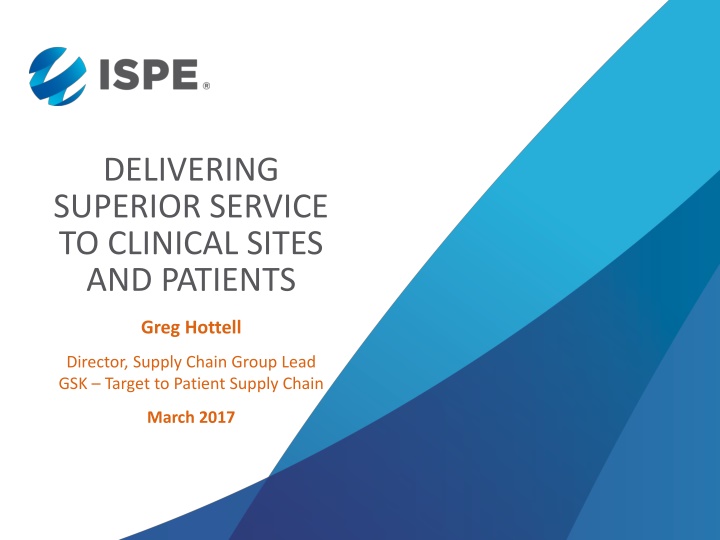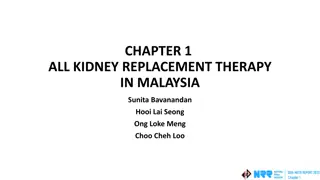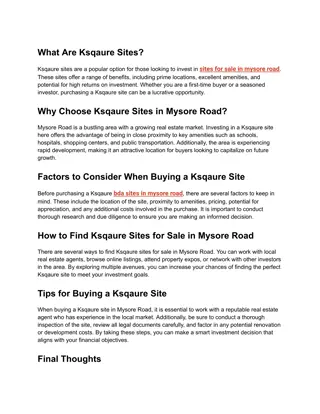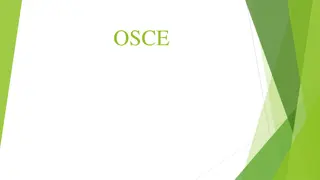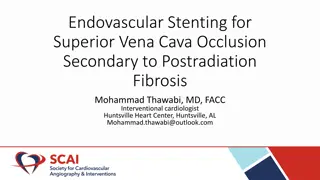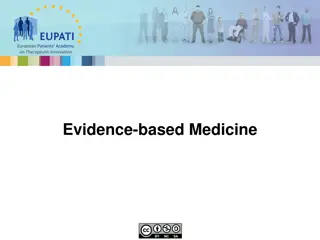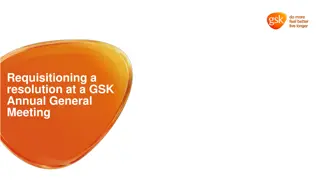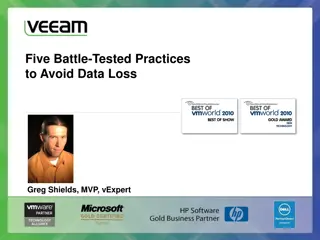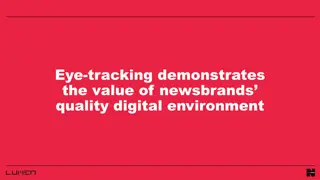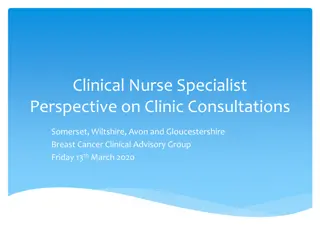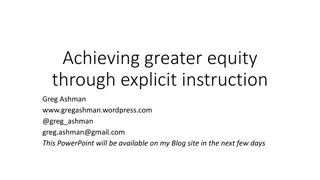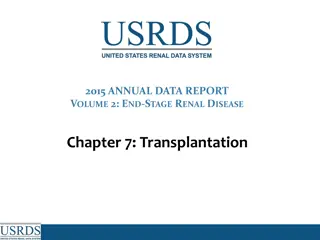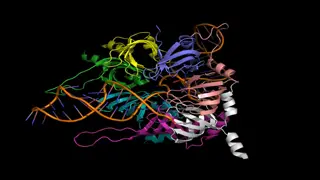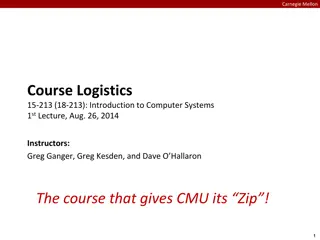Delivering Superior Service to Clinical Sites & Patients - Greg Hottell, Director, GSK
Providing a detailed overview of GSK's improvement journey, learnings, and achievements in clinical site performance. Explore the CenterWatch Survey results and the evolution of GSK's reputation as a top-tier sponsor. Understand how the GSK Clinical Supply Chain significantly improved in 2015. Connect with industry insights and best practices shared by Greg Hottell in March 2017.
Download Presentation

Please find below an Image/Link to download the presentation.
The content on the website is provided AS IS for your information and personal use only. It may not be sold, licensed, or shared on other websites without obtaining consent from the author.If you encounter any issues during the download, it is possible that the publisher has removed the file from their server.
You are allowed to download the files provided on this website for personal or commercial use, subject to the condition that they are used lawfully. All files are the property of their respective owners.
The content on the website is provided AS IS for your information and personal use only. It may not be sold, licensed, or shared on other websites without obtaining consent from the author.
E N D
Presentation Transcript
DELIVERING SUPERIOR SERVICE TO CLINICAL SITES AND PATIENTS Greg Hottell Director, Supply Chain Group Lead GSK Target to Patient Supply Chain March 2017
Delivering Superior Service Session Agenda 1. Introduction & review agenda 2. Section One: Overview of the CenterWatch Survey 3. Section Two: The GSK Improvement Journey 4. Section Three: What we learned along the way Greg Hottell March 2017 5. Open Forum; Q&A ispe.org Connecting Pharmaceutical Knowledge
Section One Overview of the CenterWatch Survey Measuring sponsor performance at the clinical site foundation/history-and-mission/lombardi-what-it-takes-to-be-1.aspx Source: http://www.lombardifoundation.org/about-the-cancer- If winning isn t everything, why do they keep score? Vince Lombardi Hall of Fame Football Coach 1913 1970 Greg Hottell March 2017 ispe.org Connecting Pharmaceutical Knowledge
Introduction to the CenterWatch Survey Providing context for those unfamiliar with the survey 2015 CWM Survey Responses 2% A global survey of clinical sites & investigators North America 7% South America 24% Europe Conducted every 2 years 13% Asia Pacific 53% Africa & Caribbean ~2,000 responses Source: 2015 CenterWatch Global Investigative Site Survey; General Sponsor Analysis, April 2015. Looking at key sponsor <-> site relationship factors Ranking of sponsors based on their relative performance Greg Hottell March 2017 Comparisons to prior survey results to detect trends and opportunity areas ispe.org Connecting Pharmaceutical Knowledge
Looking at 2013 Results (Baseline) GSK was not recognized as top tier based on performance GSK was not ranked as a top- tier sponsor in 2013 Opportunity: Not on the leader board for performance Consolation: Considered one of the top-5 sponsors by reputation: Source: The CenterWatch Monthly March 2013; Volume 20, Issue 03 Greg Hottell March 2017 the 2013 survey, for the first time, measured the reputations of sponsors among sites. The top five companies, based on reputation alone, were Novartis, Roche, Sanofi, GlaxoSmithKline, and Pfizer. Source: The CenterWatch Monthly March 2013; Volume 20, Issue 03 ispe.org Connecting Pharmaceutical Knowledge
How the GSK Clinical Supply Chain Scored in 2015 Significant improvement in results from the 2013 baseline GSK was recognized by CenterWatch Monthly as a top- performing sponsor Source: The CenterWatch Monthly March 2015; Volume 22, Issue 03 Including top-tier performance in Timely Drug Availability for clinical sites Greg Hottell March 2017 Source: 2015 CenterWatch Global Investigative Site Survey; General Sponsor Analysis, April 2015. ispe.org Connecting Pharmaceutical Knowledge
How Did We Do It? Explaining the change in performance from 2013 to 2015 The change in results from 2013 to 2015 was a tremendous success for our team The culmination of persistent focus on a few key improvement areas Greg Hottell March 2017 ispe.org Connecting Pharmaceutical Knowledge
Section Two The GSK Improvement Journey Taking action to improve service for sites and patients What patients want is not rocket science, which is really unfortunate because if it were rocket science, we would be doing it. We are great at rocket science. We love rocket science. What we re not good at are the things that are so simple and basic that we overlook them. Source: https://www.amazon.com/Putting-Patients-First- Practicing-Patient-Centered/dp/0787964123 Laura Gilpin Greg Hottell March 2017 Nurse, Author, and Poet 1950 2007 ispe.org Connecting Pharmaceutical Knowledge
The GSK Improvement Journey 4 key action areas to improve performance for sites and patients 1. Getting back to the basics 1 Consistent execution of the fundamentals 2. Implementation of an end-to-end planning platform 2 Overage and waste reduction emphasis Proactive risk management 3. Clear accountability for on-time patient delivery 3 4. Defining and enhancing the interface with Clinical 4 Greg Hottell March 2017 Relationships across functions Cross-functional steering committee ispe.org Connecting Pharmaceutical Knowledge
1 1. Clinical Supplies Getting Back to the Basics Refocusing on our primary reason for existence We had to get on the same page as to who our customers are and our reason for existence: To design and execute clinical supply chains that deliver on-time to patients while supporting the potential of the R&Dpipeline. It is our responsibility to create effective plans that are able to survive in the real world Greg Hottell March 2017 ispe.org Connecting Pharmaceutical Knowledge
1. Clinical Supplies Getting Back to the Basics (cont.) The reality of clinical supplies management 1 In our business, pressure comes from uncertainty and the need to serve 2 masters: On-time, Every time At minimal cost / least waste DEMAND SUPPLY Cost pressures continue to mount for many Pharma companies dealing with declining revenues due to patent losses for blockbuster medicines. Greg Hottell March 2017 ispe.org Connecting Pharmaceutical Knowledge
1. Clinical Supplies Getting Back to the Basics (cont.) Building a framework for a consistent tool kit 1 1. One global organization (vs. regional model) 2. Clear mission and sense of purpose 3. Core skills reinforced: vs. Brute Force Approach: Defining and documenting key assumptions Demand modeling & demand planning Aligning on deliverables and due dates Supply planning & inventory management Greg Hottell March 2017 4. Risk Planning & Risk logs ispe.org Connecting Pharmaceutical Knowledge
2 2. Implementing an End-to-End Planning Platform Planning extends from API to Patient Consumption On a monthly basis, translate patient enrollment (demand) information into a plan for supply activities needed to support GSK studies Patient Enrollment projections Patient Kit consumption rates Manufacturing Activity Packaging Activity Linking patient demands all the way back to manufacturing provides end-to- end visibility for how a change in clinical demand translates into revised requirements for operations or how a change in supply availability might impact delivery for patients. Planning occurs at multiple levels: Patient Kit Demand Greg Hottell March 2017 Secondary Packaging Primary Packaging Drug Product API ispe.org Connecting Pharmaceutical Knowledge
2 2. Implementing an End-to-End Planning Platform (cont.) Linking the Clinical supply chain from API to Patient Kit Involved closing gaps and building interfaces across disparate systems SIMPLIFIED ILLUSTRATION: Clinical Development Plan PLANNING IP Demand Modeling & Demand Planning Supply Chain Strategy & Supply Planning (API to Patient Kit) MRP + Inventory Management DRP IRT EXECUTION Patient Dispensing & Site Inventory Drug Substance Manufacture Drug Product Manufacture Packaging and Labeling Distribution and Logistics Greg Hottell March 2017 This fundamentally changed the nature of the Study Lead role New-found visibility allowed us to challenge decisions and intervene ispe.org Connecting Pharmaceutical Knowledge
2 2. E2E Planning Enabled Significant Improvements Leveraging E2E planning to drive value through the supply chain Demonstrating the value of Supply Chain Management: Shifting focus from Overage planning to Forward Cover Challenging spend events & delaying expenses to be as close as possible to the need / trigger Tangible results: o 10M to 20M in savings and cost avoidance realized annually o Reversed expansion trend in pilot plant capacity o Improved supply responsiveness Greg Hottell March 2017 ispe.org Connecting Pharmaceutical Knowledge
3 3. Clear Accountability for On-Time Patient Delivery On-time delivery to the patient as the overarching goal Before, it was too easy to pass the issue along to someone else ( they should have done something differently ) Stock Out Cause o We were not doing a good enough job of getting to true root cause o Corrective actions were not driving significant improvement fast enough Solution: Establish a single, visible owner for on-time delivery Greg Hottell March 2017 o Leverage E2E planning platform for visibility and single voice o Drive cross functional alignment to an improvement plan and actions o Especially important at key interfaces where gaps tend to form ispe.org Connecting Pharmaceutical Knowledge
4 4. Defining and Enhancing the Interfaces with Clinical Improving the interfaces between supply and demand Cross-functional initiative to identify and improve the barriers to higher performance Focused on key milestones and defining a RACI for deliverables and handoffs to other teams Highlighted (and addressed) a lack of understanding of upstream and downstream activities Greg Hottell March 2017 ispe.org Connecting Pharmaceutical Knowledge
What Did We Learn? As with any journey, learning was a critical component Back to Basics The improvement from 2013 to 2015 was the culmination of significant effort over the course of several years E2E Planning Platform We weren t always perfect, but welearneda lot along the way Focus on Patient Delivery Greg Hottell March 2017 Enhanced Interfaces ispe.org Connecting Pharmaceutical Knowledge
Section Three What We Learned Along the Way Key lessons learned from a multi-year journey Source: https://en.wikipedia.org/wiki/Abraham_Maslow I suppose it is tempting, if the only tool you have is a hammer, to treat everything as if it were a nail. Abraham Maslow American Psychologist 1908 1970 Greg Hottell March 2017 ispe.org Connecting Pharmaceutical Knowledge
What We Learned Along the Way Key lessons from the journey to improved performance 1. Training, Culture and Relationships as a foundation 2. E2E visibility and control over the supply chain is crucial 3. Overages and Waste are often a red herring 4. Ultimately, Supply Chain Agility is key Greg Hottell March 2017 ispe.org Connecting Pharmaceutical Knowledge
1. Training, Culture and Relationships as a Foundation The softer side of change is the most important first step GUIDING PRINCIPLE: If your people don t know what they are doing, nothing else really matters. Upgrading and changing business tools and processes without considering the necessary skill sets was an early misstep Any improvement initiative MUST consider the human side of change GUIDING PRINCIPLE: If people can t agree in times of ease, they will be at each other s throats in times of pressure. If the root causes of conflict are not addressed, improvement initiatives will simply delay the inevitable. Greg Hottell March 2017 Focus on creating positive reinforcement cycles ispe.org Connecting Pharmaceutical Knowledge
2. End-to-End Visibility and Control E2E planning framework is a key enabler to higher performance GUIDING PRINCIPLE: If you can t see it, you can t manage it. Disconnected systems and lack of visibility = delays & supply risk This creates the Jump Scare of clinical supplies (the problem you don t see coming till it is too late ) Supply Chain Strategy + Demand & Supply Planning MRP + Inventory Management DRP IRT Patient Dispensing & Site Inventory Drug Substance Manufacture Drug Product Manufacture Packaging and Labeling Distribution and Logistics Greg Hottell March 2017 The solution does NOT have to be a full-blown ERP platform (although it can certainly help ) ispe.org Connecting Pharmaceutical Knowledge
3. Overages and Waste are Often a Red Herring It can be easy to get distracted by alternate goals When it comes to our primary objective, Waste and Overages are often red herrings They are outcomes of the process, as opposed to the primary deliverable. Greg Hottell March 2017 GUIDING PRINCIPLE: If you can t explain simply what the inventory is for, you don t really have an inventory plan. ispe.org Connecting Pharmaceutical Knowledge
3. Overages as a Potential Red Herring Utilizing inventory to help us achieve our primary objective CTM supply needs to be highly flexible, yet immediately responsive Flexibilityallows us to reallocate stock From one dose form to another From one study to another From one language pool to another From one clinical site to another While minimizing waste Responsivenessto meet patient needs The right dosage forms For the right study In the right quantities At the right places At the right time Greg Hottell March 2017 ispe.org Connecting Pharmaceutical Knowledge
4. Ultimately, Supply Chain Agility is Key Using an agile approach to replace the need for high overages GUIDING PRINCIPLE: If a key part of the plan is predictably unpredictable, formally prepare your supply chain to adapt. The necessary tradeoff between flexibility and responsiveness means that inventory alone only gets us so far in achieving our primary objective The supply chain needs to be designed and operated to ensure it is agile : supply chain agility can be defined as a firm s ability, in conjunction with its key suppliers and customers, to quickly and effectively react to changes in environment. Greg Hottell March 2017 Source: Blome, Constantine, et al. Antecedents and Enablers of Supply Chain Agility and its Effect on Performance: A Dynamic Capabilities Perspective. International Journal of Production Research. Vol. 51, No. 4., 15 Feb 2013. Agility does not have to be about cutting edge or highly advanced production capabilities in many cases, it is about getting the fundamentals right ispe.org Connecting Pharmaceutical Knowledge
4. Ultimately, Supply Chain Agility is Key (cont.) An illustration of what I mean by agility We know that variability is a huge factor in our business, leading to supply risk: In a basic supply chain, supply risk is a function of variability during the replenishment lead time. Agility helps to address the risk and assure supply: Source of Agility: Inventory at node Cycle Time Upstream reserve Source of Risk: Demand variability Supply variability Lack of visibility DEMAND Supplier Customer SUPPLY How we have chosen to approach agility: Greg Hottell March 2017 Maintain some internal packaging, labeling & distribution capability Leverage externalized capabilities where appropriate Strategic inventory placement (relative to capability) along the supply chain Strong emphasis on E2E visibility & rapid identification of hot spots ispe.org Connecting Pharmaceutical Knowledge
Bringing it All Together The Journey to Improved Delivery for Sites and Patients Greg s Roadmap for Improved Performance: Following through relentlessly on the plan AND its myriad contingencies Optimal placement of inventory relative to capabilities to ensure rapid response Collaborative planning for what might happen with disciplined planning for contingencies Establishing the control tower with an appropriate infrastructure Healthy & engaged teams working collaboratively across functions Mandatory fundamentals Greg Hottell March 2017 ispe.org Connecting Pharmaceutical Knowledge
About the Presenter: Greg Hottell is a Director in the Clinical Interface team at GSK, where he is responsible for the cost-effective, patient-focused supply of investigational product for GSK s pharmaceutical development portfolio. Since joining GSK in 2011, Greg implemented an end-to-end planning platform for clinical supplies, helped redesign GSK s approach to clinical supply blinding and unblinding risk management, was a core team member for the Investigational Material Supply strategic planning initiative, all while consistently delivering top-tier performance with on- time supply of investigational product to patients. Greg has been a Supply Chain professional since 1999, most recently holding positions of increasing responsibility at Eli Lilly & Company and Fisher Clinical Services prior to joining GSK. Greg has a diverse background in the Pharmaceutical Industry spanning roles that include clinical trial materials management, demand planning, site inventory management, IRT utilization, drug product supply planning, temperature excursion management, study drug expiry dating extensions, customer service, operations planning & scheduling, and procurement. Greg holds a bachelor s degree in Operations Management, an MBA, and is a Certified Fellow in Production and Inventory Management (CFPIM) through APICS.
